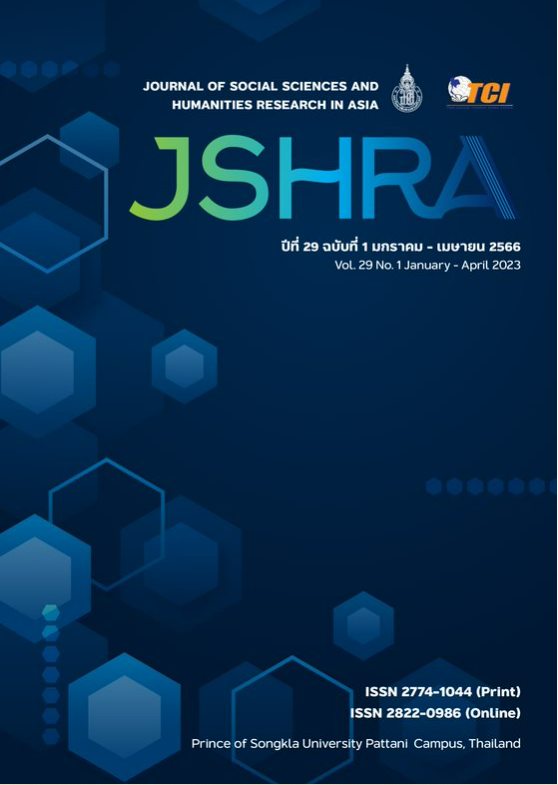The Role of Servicescape and Social Interaction Affecting Customer Service Experience in the Coffee Shop
Abstract
This research aims to investigate the servicescape and social interactions, affecting customer sevice experience in coffee shops. The online survey was used to gather data from 400 regular coffee shop customers, residing in Bangkok Metropolitan region, selected by convenience sampling. The data were analyzed, using descriptive and multiple regression analyses to test hypotheses. The findings reveal that service space (B = 0.25), and signs and symbols (B = 0.201) had positive influence on customer service experience at a significant level of .05. As for social interactions, comprising of two sub-factors; customer-to-customer (B = 0.416) and customer-to-employee interactions (B = 0.351) also had positive influence on customer service experience at a significant level of .05. In addition, one-way ANOVA suggests that coffee shop entrepreneurs focus on clients with high expectations for customer service experience, aged 41 years old or older with a bachelor's degree or above. This study helps coffee shop owners enhance the customer service experience in their coffee shops by improving servicescape and social interaction.
References
Albert, H.V. (1971). Social interaction in education setting. New Jersey: Prentice Hall.
Bitner, M.J. (1992). Servicescapes: The impact of physical surroundings on customers and employees. Journal of Marketing, 56(2), 57 - 71.
Buaboos, B. (2015). Interactive product design for cafe (Master of Fine Arts). Silpakorn University.
Cochran, W.G. (1977). Sampling techniques. New York: John Wiley & Sons.
English, H.B., & English, A.C. (1959). A comprehensive dictionary of psychological and psychoanalytical terms: A guide to usage. Harlow: Longmans.
Ferreira, J., Ferreira, C., & Bos, E. (2021). Spaces of consumption, connection, and community: Exploring the role of the coffee shop in urban lives. Geoforum, 119, 21 - 29.
Fitzsimmons, J., & Fitzsimmons, M. (2006). Service management (7th ed.). Singapore: McGraw - Hill.
Gentile, C., Spiller, N., & Noci, G. (2007). How to sustain the customer experience: An overview of experience components that co - create value with the customer. European Management Journal, 25(5), 395 - 410.
Gremler, D.D., & Gwinner, K.P. (2000). Customer - employee rapport in service relationships. Journal of Service Research, 3(1), 82 - 104.
Happ, E., Scholl - Grissemann, U., Peters, M., & Schnitzer, M. (2021). Insights into customer experience in sports retail stores. International Journal of Sports Marketing and Sponsorship, 22(2), 312 - 329.
Jeloudarlou, S.N., Aali, S., Faryabi, M., & Zendeh, A.B. (2022). The effect of servicescape on customer engagement: The mediating role of customer experience. Journal of Quality Assurance in Hospitality & Tourism, 23(2), 318 - 344.
Kim, H.S., & Choi, B. (2016). The effects of three customer - to - customer interaction quality types on customer experience quality and citizenship behavior in mass service settings. Journal of Services Marketing, 30(4), 384 - 397.
Kotler, P. (1973). Atmospherics as a marketing tool. Journal of Retailing, 49(4), 48 - 64.
Kruawang, P., & Phungbangkruay, J. (2018, February 22-23). Servicescape affecting customer experience of Yomjinda retro market road, Rayong Province. [Conference session]. The International and National Conference in Business Administration and Accountancy 2018, KhonKhan, Thailand.
Lemke, F., Clark, M., & Wilson, H. (2011). Customer experience quality: An exploration in business and consumer contexts using repertory grid technique. Journal of the Academy of Marketing Science, 39(6), 846 - 869.
Lovelock, C., Wirtz, J., Keh, H.T., & Lu, X. (2004). Services marketing in Asia (2nd ed). New Jersey: Prentice Hall.
Motoki, K., Takahashi, A., & Spence, C. (2021). Tasting atmospherics: Taste associations with colour parameters of coffee shop interiors. Food Quality and Preference, 94, 104 - 315.
National Food Institute. (2019). Coffees in Thailand. Retrieved October 18, 2021, from http://
fic.nfi.or.th/upload/market_overview/JUN2019Thailand_ Coffee.pdf
Ngerthaworn, S.C. (2020). Social interaction by social network: A case study of Nakhon Si Thammarat Rajabhat University students. Narkbhutparitat Journal, 12(1), 77 - 85.
Nunnally, J.C., & Bernstein, I.H. (1967). Psychometric theory. New York: McGraw - Hill.
Phamontri, P. (2019). The development of creative drama to enhance the social interaction of youth: A case study of youth in sub - sin 26 - 7 community building, Klong Toey, Bangkok (Master of Education). Srinakharinwirot University.
Shaw, C., & Ivens, J. (2005). Building great customer experiences. Hampshire: Palgrave MacMillan.
Sirimongkol, T. (2020). A conceptual model and propositions: Servicescape influencing on behavioral intention in context of coffee shop. Vocational Education Innovation and Research Journal, 4(1), 121 - 129.
Siu, N.Y. M., Wan, P.Y.K., & Dong, P. (2012). The impact of the servicescape on the desire to stay in convention and exhibition centers: The case of Macao. International Journal of Hospitality Management, 31(1), 236 - 246.
Sombultawee, K. (2018). The relationship between marketing factors and fresh coffee shop’s consumer loyalty in Bangkok. Hatyai Academic Journal, 16(1), 21 - 37.
Sopha, S. (2019). The landscape design and improvement project of love cups café Bang Bua Thong district, Nonthaburi province (Special Problem, Bachalor of Science). Rajamangala University of Technology Thanyaburi.
Stein, A., & Ramaseshan, B. (2020). The customer experience–loyalty link: Moderating role of motivation orientation. Journal of Service Management, 31(1), 51 - 78.
Sukrith, K. (2014). Service marketing mix and behavior toward Japanese restaurants in community mall of customers in Bangkok Metropolis (Mater’s thesis). Srinakharinwirot University.
Tran, Q. X., Dang, M. V., & Tournois, N. (2020). The role of servicescape and social interaction toward customer service experience in coffee stores. The case of Vietnam. International Journal of Culture, Tourism and Hospitality Research, 14(4), 619-637.
Tuguinay, J.A., Prentice, C., & Moyle, B. (2022). The influence of customer experience with automated games and social interaction on customer engagement and loyalty in casinos. Journal of Retailing and Consumer Services, 64(1), 102830.
Tunyawan, W. (2019). The effects of servicescape and service quality on customer satisfaction of integrated accommodation in Bangkok (Independent Study, Master of Management). Mahidol University.
Wakefield, K.L., & Blodgett, J.G. (1996). The effect of the servicescape on customers’ behavioral intentions in leisure service settings. Journal of Services Marketing, 10(6), 45 - 61.
Wigraisakda, K., & Kittisaknawin, C. (2019). The importance of customer experience in service business: Building competitive advantage in future global marketing trend. Veridian E - Journal Silpakorn University, 27(2), 537 - 555.
Zeithaml, V.A., Bitner, M.J., & Gremler, D.D. (2009). Services marketing: Integrating customer focus across the Firm (5th ed.). Singapore: McGraw - Hill.











